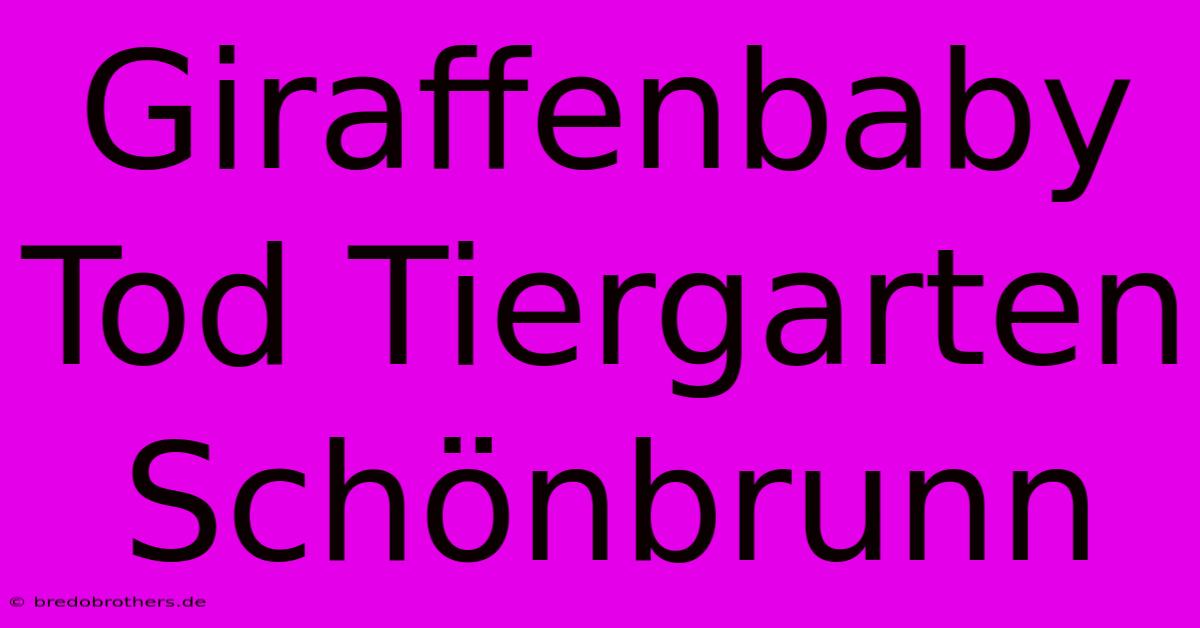Giraffenbaby Tod Tiergarten Schönbrunn

Discover more detailed and exciting information on our website. Click the link below to start your adventure: Visit Best Website Giraffenbaby Tod Tiergarten Schönbrunn. Don't miss out!
Table of Contents
Giraffenbaby Tod Tiergarten Schönbrunn: A heartbreaking loss and lessons learned
It’s with a heavy heart that I write about the recent death of a baby giraffe at Tiergarten Schönbrunn. This isn't just some news story to me; it hit me hard. I've always been fascinated by giraffes – those majestic creatures, so elegant and graceful. To hear about the loss of such a young one, especially in a place dedicated to their care, felt deeply personal.
The Sad News and Initial Reactions
The news spread quickly, of course. Social media was buzzing. People were heartbroken, expressing their sadness and anger. I admit, I was angry too. How could this happen? What went wrong? Questions swirled, and honestly, the initial reports were pretty confusing. There was talk of complications, of a sudden illness... but the details were scarce. It felt like a punch to the gut, you know? One minute you're seeing adorable pictures of the little one, the next... silence. A void.
Understanding the Complexity of Wildlife Care
Now, looking back, I understand things were more complicated than they initially seemed. Caring for animals, especially exotic ones like giraffes, is incredibly complex. It's not just about providing food and water; it’s about understanding their intricate biology, their social dynamics, and their specific needs. A tiny detail overlooked can have massive consequences. That's a really important lesson for me and, hopefully, for others.
My Experience with Animal Conservation Efforts (A Personal Anecdote)
Years ago, I volunteered at a smaller wildlife sanctuary. It wasn’t nearly as large as Schönbrunn, but the experience taught me so much about animal welfare. We had a baby deer – a fawn – who was struggling with digestive issues. It was a long, stressful time. We monitored every detail: food intake, bowel movements, its overall behavior. Even small changes – the way it was interacting with the other deer, its posture – were carefully noted.
The vet, bless her, worked tirelessly. We tried various treatments, and let me tell you, it was heart-wrenching. We ultimately succeeded – the fawn pulled through. But the experience ingrained in me the importance of meticulous observation, quick reaction, and the collaborative effort needed to give animals the best possible chance of survival.
What Schönbrunn Could Do Better
With the giraffe calf’s death, it's important to emphasize that pointing fingers doesn't bring the little one back. However, a thorough investigation is absolutely crucial. Transparency is also essential. The public deserves to know what happened, what steps were taken, and what measures will be implemented to prevent similar tragedies in the future. Transparency builds trust.
A few points: Improving communication to the public is vital. More frequent and detailed updates, possibly even a blog or dedicated social media channel, could help manage expectations and provide a sense of closure. Sharing information, even bad news, with honesty can help people better understand the complexities of wildlife care.
Beyond that, we also need to understand the broader picture. What are the underlying causes of animal mortality in zoos and wildlife parks? What advancements in veterinary care, animal husbandry, or overall conservation efforts can we improve to reduce these unfortunate incidents?
Remembering the Little One
Let’s remember the short life of this giraffe calf. Let's honor its memory by learning from this loss and working towards a future where such incidents are far less frequent. It’s a tough pill to swallow, but perhaps its passing can serve as a catalyst for positive change. Let's focus on positive action, because that is what the little giraffe deserves.
This is a tragedy. Let's learn from it and hope to prevent future losses.

Thank you for visiting our website wich cover about Giraffenbaby Tod Tiergarten Schönbrunn. We hope the information provided has been useful to you. Feel free to contact us if you have any questions or need further assistance. See you next time and dont miss to bookmark.
Featured Posts
-
19 Grad Wochenstart Nach Schnee Und Sturm
Nov 29, 2024
-
Punktverlust Uecl Ligaphase Beendet
Nov 29, 2024
-
I Phone Black Friday 2024 3 Top Angebote
Nov 29, 2024
-
Heidenheim Ueberrascht Fast Chelsea
Nov 29, 2024
-
Teurer Trainerwechsel Bei Man U
Nov 29, 2024
